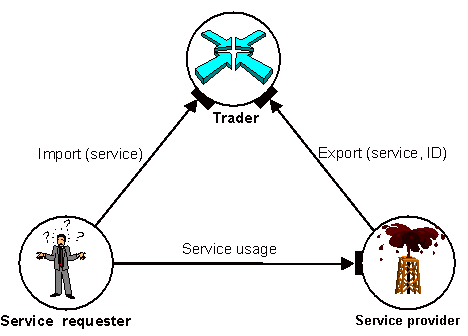|
AI-TraderIntroductionThe continuous merging of numerous local computer networks has resulted in an open distributed system. In this environment services are freely offered and requested. New service providers are constantly emerging and advertising their products in this electronic market place, while others are leaving the system. The resulting fluctuation of service offers adds to the complexity of an open distributed system. It is impossible for a user to gain a complete overview of the services currently offered. The dynamics and size of such an environment implies, that the knowledge about its structure decreases proportional with the increase in time. Several institutions work on technology independent standards which define frameworks for open distributed systems. For example the International Organization for Standardization (ISO) and the International Telecommunication Union, Telecommunication Standardization Sector (ITU-T) have developed the Reference Model for Open Distributed Processing (RM-ODP). The RM-ODP describes an architecture which supports the distribution, interoperability and portability of software components. Furthermore the RM-ODP demands the support of a trading function which assists in the search for services. All participating parties in an open distributed system assume the roles of service providers and service requesters, which have no a priori knowledge about each other. In particular they are not linked statically to each other, but rather dynamically when the need arises. In the RM-ODP the trading of services is based on a mediation process. During the mediation of services another party assumes the role of a trader, whose task is to match service offers and requests (see Figure 1). According to the RM-ODP a mediation process is divided into several steps. First a service provider exports its service offer with the trader. At a later point in time a service requester tries to import a particular service. If the trader finds a matching service offer, which has previously been exported, it responds a reference to the service requester pointing to the appropriate provider. After a successful mediation process the service requester and provider are bound to each other and start to interact.  Figure 1: RM-ODP trader model The notion of a type system is essential for the discussion of a mediation process. For one thing a type system defines a type specification language, which allows the specification of services in open distributed systems. Furthermore a type system defines rules, which allow the association of service offer and request, both represented as type specifications. The type specification language of the RM-ODP focuses on operational aspects of a type specification, i.e. how a service is accessible from a programming point of view. Within a global system, where programmers as well as application users are exposed to the mediation process, the selection of type specifications is of equal importance. This emphasizes the need for semantic service type specifications, which allow the description of services with identical operational interfaces but different qualitative characteristics. [an error occurred while processing this directive] |